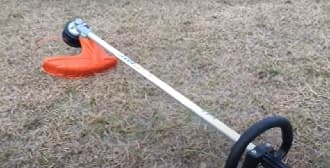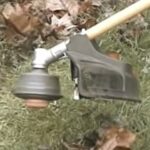As an Amazon Associate, this site earns commissions from qualifying purchases. For more information click here.
If your weed eater is having trouble starting and smells of gas, its engine is probably flooded. Check the spark plug and if it is soaking in gas, it is confirmed. Fortunately, fixing a flooded engine is easier than you might think.
Use a wrench to pull the spark plug out and squeeze the throttle trigger. Set the choke to the “run” position and pull the cord 8-10 times. Put the spark plug back on and while holding the trigger down, pull the start cord.
Signs of a Flooded Weed Eater
A flooded weed eater is hard to start. You can pull the starter cord several times but nothing happens. If you do get the engine to run, it smells strongly of gas and there is a lot of white smoke as well.
What is happening is there is too much fuel compared to the air in the engine. The combustion chamber is being flooded with fuel and not enough air to balance it out.
In many cases, the fuel spills out as the float valve gets stuck. The spark plug gets wet from the fuel and this affects its ability to function. And if the spark plug is not running properly, you cannot start a weed eater engine. Not only is there a mess inside the engine, but you can smell the gasoline much stronger than usual.
How to Unflood a Weed Eater
The video shows how to un-flood a small engine. This is applicable for weed eaters like the Husqvarna 122HD60. It also works for lawn mowers, chainsaws, leaf blowers and other small engines. If you would like step by step instructions, follow the guide below.
What You Need
- Safety goggles
- Gloves
- Adjustable wrench (check your owner’s manual for compatibility)
- Towel or rags
- New spark plug (if necessary)
Step 1
Put on the safety goggles. Wear gloves and be careful since you are going to handle fuel. Prepare all the required tools and materials. You should also have your owner’s manual by your side too.
If is also a good idea to have a new spark plug ready. The current one might just be dirty and still usable. But if it is damaged, you should have one available.
Step 2
Turn the weed eater off. Take it outdoors if you have not done so already. Set the weed eater down on an even surface. The place must be outdoors, well ventilated and without any flammable objects nearby.
Step 3
Wait for the engine to cool off. If it is hot outdoors, move the weed eater under shade, but do not bring it indoors. When the engine is no longer hot to touch, pull off the spark plug cap. The cap is usually black and connected to a rubber covered wire.
Step 4
After removing the cap, you should see the spark plug now. Use a wrench to remove the spark plug. Turn the wrench counterclockwise until the spark plug comes loose.
Take the spark plug off and examine it. If the engine is flooded it will be wet and reek of gas. Check for bends, cracks or other signs of damage. If there is none, you can wipe the spark plug clean and use it again. Replace the spark plug if it is damaged.
Step 5
When an engine is flooded, the excess gas ends up in the carburetor combustion chamber. Check the carburetor and clean it up.
Step 6
Press the throttle. In a typical weed eater, the throttle is at the shaft underside under the engine. Check your owner’s manual if you are not sure.
Step 7
Set the choke lever to “run”. Next, pull the starter cord about 8-10 times. In some cases you only need to do this 6 times, it varies. Make sure to pull quickly.
Step 8
Use the towels to wipe dirt and excess fuel off the machine. Put a new (or newly cleaned) spark plug back. Place the spark plug cap on.
With everything restored, hold the trigger down and pull the cord. Your weed eater is now flood free and will start.
Why Your Weed Eater Keeps Flooding
There are many reasons why weed eater engines flood. The causes are similar to those of lawn mowers, leaf blowers and other small engines. Here are the most common reasons, and we also provide tips to avoid them.
Too Much Fuel
Too much gas stored for too long can flood the engine. Whether you own a Husqvarna 128LD or another brand, this is likely going to happen. The excess fuel will spread throughout the carburetor and food it. Worse, old fuel becomes gummy and could stall the engine.
How to fix it. Remove all the fuel in the tank. Disconnect the spark plug and check if the carburetor is flooded. Drain all the fuel away. Clean the carburetor and fuel tank. Pour new fuel and reconnect the spark plug. The engine should be fine now.

Dirty Air Filter
Small engines need the right air to fuel mix to avoid flooding. A dirty air filter prevents air from getting into the combustion chamber. There is a steady supply of gas but with limited air, the mixture will be uneven. Too much fuel and you get a recipe for flooding.
How to fix it. Take the air filter out and clean it. If the filter is too dirty or damaged, replace it. Go to the air intake port and add some starter fluid.
Set the choke to off and turn on the engine. You will see smoke and smell gas, but that is just the excess fuel being burned. After a minute or so all the smoke will dissipate. Shut the weed eater off, put the air filter back and turn it on again.
Choke is Engaged
The engine is going to flood if the choke is left engaged. This can happen if you pull the cord repeatedly because the engine was flooded.
How to fix it. Once the engine starts, turn the choke off.
When choke is on, more fuel goes into the engine than what is required. That is why you have to turn the choke off as soon as the engine runs normally. On the other hand, if your weed eater keeps bogging down, check out our guide. LNK
Another way to fix engine flooding is to simply let the weed eater run for 10-20 minutes or so. Wait for the engine to burn the extra fuel. This is going to take a while though, and if you need the weed eater, the method provided earlier is the best option. Do not forget to take the spark plug while doing this. It helps the un-flooding process.
Clogged Float Valve
The float valve regulates the flow of fuel in the engine. It is an integral part of the carburetor as it ensures the right amount of fuel goes into the engine.
The valve can stop working due to wear and tear. It can also get stuck if old fuel has turned gummy. Since the valve controls the needle that blocks fuel inflow, it can cause a big problem.
How to fix it. Buy a carburetor rebuild kit and replace the damaged parts. Clean the carburetor first if there is old fuel residue. Look for a rebuild kit that is compatible with your weed eater as these machines have different specs.
Malfunctioning Spark Plug
If the spark plug is corroded or dirty, it won’t run like it should. It might not produce the spark needed for fuel and air mixture. Bottom line is that a faulty spark plug can lead to weed eater flooding.
How to fix it. Turn your weed eater on and let it idle for 12-15 minutes. Look into the spark plug for signs of gas. Wipe any traces and try again. Replace the spark plug if the engine still won’t run regularly.

I love the outdoors and all the tools for maintaining gardens, yards and lawns. The only thing I am more passionate about is sharing what I know about garden and outdoor equipment.


